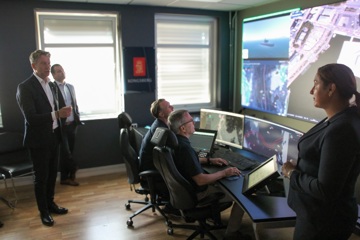KONGSBERG’s Three-Pillar Protection Framework
The Oslofjord Test Bed supports KONGSBERG’s unified infrastructure protection model, built on three operational pillars:
- Situational Awareness: Building the Operational Picture
Effective protection starts with understanding. KONGSBERG’s systems fuse data from radar, satellite, acoustic and environmental sensors to create a shared situational picture. Machine learning models help identify anomalies—such as unusual vessel behavior or seabed changes—while intuitive interfaces support decision-making and coordination.
- Response & Inspection: From Detection to Confirmation
When a potential threat is detected, rapid investigation is key. KONGSBERG deploys autonomous platforms like the HUGIN AUV and precision ROVs to inspect and verify anomalies. These systems operate at extreme depths and distances, carrying advanced payloads for sonar imaging, navigation and visual inspection. The test bed enables full workflow simulation—from alert to inspection—supporting both technology refinement and operator training.
- Surveillance & Monitoring: Ensuring Long-Term Integrity
Beyond reactive response, infrastructure requires persistent monitoring. The facility supports evaluation of long-duration patrols, seabed acoustic nodes, satellite-based change detection and geofenced behavioral analytics. These tools help distinguish between normal variation and actual threats, enabling predictive maintenance and lifecycle optimization.
A Platform for Collaboration and Preparedness
The Oslofjord Test Bed aligns with national and European policy goals. It supports Norway’s Total Preparedness strategy and contributes to EU initiatives such as the Critical Entities Resilience Directive and the EU-NATO Task Force on Infrastructure Resilience.
“The Oslofjord Test Bed provides a concrete tool to strengthen maritime preparedness,” said Norwegian Minister of Energy Terje Aasland. “It shows how Norwegian technology and innovation can be applied to meet new threats and higher demands for security.”
KONGSBERG’s commitment goes beyond technology — it’s about enabling informed protection through collaboration, integration and shared readiness.
“We believe maritime infrastructure is part of the foundation of democratic society,” Håøy concludes. “The Oslofjord facility is our commitment to that foundation: a place where public bodies, industry and technology meet to strengthen resilience where it matters most.”


